If there was one thing Brecht really wanted to see during our three month visit to Australia, it was Uluru. So during our search for a campervan to cross Australia, we asked more experienced people if they thought it would be doable to include this in our road trip. We found out it wasn’t a popular choice, but some people did manage it. That was enough for Brecht, we would make a loop from Sydney to Sydney, passing through the Outback. And here we are, nearly at the end of our time in Australia, utterly satisfied with Brecht’s determination. The Red Centre was definitely one of the most memorable experiences from our trip around the world so far. It’s like another world out there.
In this blogpost we’ll share our favourite parts of our visit to Uluru-Kata Tjuta National Park with you. We’ll talk about how to be prepared for the extreme conditions in the centre of Australia, and which walks to definitely do or maybe skip when you’re on a tight schedule. If you’re still deciding whether or not to visit Uluru and Kata Tjuta, the photos in this post will probably persuade you to book your ticket today rather than tomorrow.
Our Guide to Uluru-Kata Tjuta National Park
Entrance fee for Uluru-Kata Tjuta National Park
As you might have guessed, Uluru-Kata Tjuta National Park covers Uluru, Kata Tjuta and its surrounding land. It’s a UNESCO World Heritage area. To be allowed into the park and be able to explore it in all its majestic glory, you have to pay a $25 entrance fee per person at the entry station of the park. This particular pass is called the Visitor Pass and is valid for entry on three consecutive days. There is an annual pass available as well, but no day pass.
We bought our Visitor Pass close to sunset and were allowed to enter for free that night. Our ticket said to be valid for the next three days, just like it was on our visit to Angkor in Siem Reap. It’s a valuable tip if you plan on getting the most out of Uluru-Kata Tjuta National Park, but we managed to do everything in only two full days (and that extra sunset).
Surviving the extreme conditions
When you buy your entry pass you’ll receive a small map of the park and some safety information to survive the extreme conditions at Uluru-Kata Tjuta National Park. Although you may think “yeah, yeah, I know”, it’s not bad to have a look and be reminded of the dangers of extreme temperatures (36°C or above) and how to stay safe. We found ourselves thanking our lucky stars to have taken these tips to heart.
First of all, we wore a hat at all times during our visit. The sun is scalding hot, even at 8h in the morning, and large parts of the tracks are without shade. A hat is not enough though, cover yourself in sunscreen as well to prevent serious sunburn. And very important, carry and drink at least one litre of water per person per hour to prevent dehydration. Also, stay on track and don’t walk alone, you never know what can happen.
Last but not least: start your walk before 11h. We’d even say to end your walk before 11h, as it gets hot real fast, especially in the summer months when we visited. We started our walks after enjoying the sunrise and even then it was already hot. The park enforces this rule by closing some tracks during extreme temperatures, starting at 11h for the remainder of the day.
We recommend to buy a fly net as well, otherwise you’ll go crazy of the hundreds flies that keep trying to land on your face (or worse, fly right into your mouth). We bought ours for $9.95 each at the Kings Canyon Resort souvenir shop during our visit to Kings Canyon, but they only cost $4.95 at the Ayers Rock Campground reception. You’ll look ridiculous, but trust us: it’s worth it. Afterwards we could clearly see the flies photobombing some of our pictures. It’s that bad.
Visiting the Cultural Centre
When you enter Kata-Tjuta National Park, you’ll pass several signs recommending to visit the Cultural Centre first. We didn’t and there’s no need to do so, unless you want to buy the visitor guide for $2. All the information you need will be handed over when you check in at your accommodation, and again when you buy your Visitor Pass at the entrance of the park.
In the Cultural Centre you’ll find more information about the traditional owners of of the land you’re exploring, what this big rock you came to see means to them, and lots more. We learned Tjukurpa teaches the proper way to behave, including not to climb Uluru (it wasn’t prohibited until October 26th, 2019) and not to enter or photograph sacred sites. There are stories and beliefs surrounding Uluru, it’s not just a big rock. So be a responsible traveler and respect their laws and culture.
Where to stay near Uluru-Kata Tjuta National Park
During our visit to Uluru-Kata Tjuta National Park, we stayed at the Ayers Rock Campground (in our campervan). We’ll be posting a blogpost reviewing this and other campsites in the Outback soon. If you would like something more luxurious, there are a lot of other options varying in price, spread over the Ayers Rock Resort.
Being in the middle of nowhere, it was necessary for this setting, otherwise known as Yulara, to become a town on its own. There’s a supermarket, specialty shops, a post office, schools, a childcare facility, several hotels, restaurants, art galleries, a petrol station, a police and a fire station. Everything you can find in a regular town, you’ll find at Ayers Rock Resort. There’s even a free resort shuttle bus taking you to the supermarket for example.
Exploring Uluru or Ayers Rock
Uluru or Ayers Rock, the big red rock in the middle of nowhere, is probably Australia’s best known landmark. Even if you don’t know the name, you’ll probably be like “ah, that thing!” when you see a picture of this impressive natural wonder. Uluru is 3.6 km long and 348 m at its highest point. We could already see it when we were still 30 km away from Ayers Rock Campground, so imagine what it’s like to be at the base of this giant.
You can explore Uluru in different ways: from the sky, from atop a camel, from the viewing areas, and from right at the foot of this big rock. We kept to the cheap ways of enjoying Uluru and its surrounding landscapes. We watched the sunset and sunrise from the different viewing areas and did the Uluru Base Walk.
Uluru Viewing Areas
There are two viewing areas on opposite sites of Uluru to enjoy the sunset. We first checked out Talinguru Nyakunytjaku, meaning “place to look from sand dune”, which is situated on a sand dune southeast of Uluru. This spot is a popular one for the sunrise, not as much for the sunset. Broad paths lead to a big viewing platform and a small covered spot. From this point you’ll see the silhouette of Uluru and (in the distance) Kata Tjuta, with the sun going down next to Kata Tjuta. We never saw such a distinct colour palette, it was absolutely stunning. It was cloudy that night, but that probably made it even more beautiful with the sun colouring the clouds.
The Car Sunset viewing area on the other hand, is situated northwest of Uluru. This spot is the popular one, and perfect for enjoying a glass of bubbles in a comfortable chair while watching an amazing sunset. You can even stay in your car if you prefer to view the sky changing colours from the comfort of your airconditioned vehicle, free of annoying flies. If you can only pick one, we’d go for the less crowded sunset at Talinguru Nyakunytjaku.
Like I mentioned before, Talinguru Nyakunytjaku is the popular spot for an Uluru sunrise. When we arrived at 6h10, tons of people were already filling up the viewing platform from where we watched the sunset the night before. We decided to walk past the crowds to a small shelter. It’s from there Brecht took one of my favourite photos from our entire visit to Uluru-Kata Tjuta National Park: the one with the dead tree, Uluru, and a beautiful sky made up of layers of different colours.
The view left us speechless. This spot is less crowded, and makes for a view that’s slightly different from the popular image of Uluru. We heard a park ranger tell the two men she was guiding that this was her favourite sunrise spot. Brecht made another great photo of Uluru during sunrise from the Kata Tjuta Dune Viewing area, so don’t forget to look for Uluru as well when you’re enjoying the Kata Tjuta sunrise.
Hiking the Uluru Base Walk
After the Uluru sunrise at Talinguru Nyakunytjaku, we drove over to the Mala Carpark to start the Uluru Base Walk. This walk leads you all around the base of Uluru (couldn’t have guessed that, right?), a 10.6 km loop. It’s a flat walk which took us less than three hours to complete. During most of that time you’re exposed to the burning hot sun with no shade to take a rest, so do wear your hat and sunscreen, and bring enough water. Siri told us that is was already 32°C at 8h30, just to give you an idea of how hot it can be on a regular day in March.
We walked the loop in clockwise direction. The first part had a lot of information signs telling us about the history of the Aboriginals that used to live around Uluru. We passed a kitchen cave, a men’s cave, and an old people’s cave. At some points there are writings on the wall, where they taught their children and grandchildren the way of life.
We took a small detour to the Kantju Gorge. It feels a lot cooler there, in the shade near the water. When you don’t have a tour group right behing you, it’s so quiet you only hear the wind and the birds. The Mutitjulu Waterhole on the other side of Uluru was even more beautiful, and a perfect place to cool down.
During the Uluru Base Walk, you’ll encounter some culturally sensitive sites, which are clearly marked by signs. The path is further away from Uluru at those points, leading you around the sites which are sacred to the Aboriginals. You’re asked to respect their laws and culture by not leaving the path and not taking photos during those parts of the walk.
It’s quite the walk, but the Uluru Base Walk really gives you an idea of just how big this rock is. You’ll also notice lots of different features you just can’t see from afar.
Exploring Kata Tjuta or The Olgas
Kata Tjuta or The Olgas are the less popular part of the Uluru-Kata Tjuta National Park, but in some ways even more stunning than Uluru. It’s said Kata Tjuta might have been a monolith once, just like Uluru, which has been eroded into 36 seperate domes. The highest dome rises up to 546 m, almost 200 m higher than Uluru. There’s a sunset and a sunrise viewing area, and two walks taking you in between the domes. We only did the adventurous Valley of the Winds Walk, and skipped the shorter Walpa Gorge Walk.
Kata Tjuta Viewing Areas
One night, we watched the sunset from the Kata Tjuta Sunset Viewing Area. We walked to the second set of benches at the end of the path, where there were less people. This whole viewing area is not as popular as the Uluru viewing areas, so overall much less crowded. While you stand there watching the stunning view of Kata Tjuta, the sun goes down behind you revealing all sorts of beautiful colours.
Before starting the Valley of the Winds Walk through Kata Tjuta, we enjoyed the sunrise at the Kata Tjuta Dune Viewing Area. This boardwalk makes for a breathtaking 360° view as you can see both Kata Tjuta and Uluru from here. Again, this spot is not as popular as the Talinguru Nyakunytjaku viewing area is for the Uluru sunrise, but nevertheless there were a lot of people.
Hiking the Valley of the Winds Walk
The Valley of the Winds Walk, taking you through the domes of Kata Tjuta, is without a doubt one of our favourite hikes so far. We started this 7.4 km loop after the Kata Tjuta sunrise, and arrived back at the car park just over two hours later. We hiked the loop in counterclockwise direction, taking us first in between a couple of domes situated fairly close together. This is the recommended direction, because you’ll do the hardest (and most fun) part first, when it’s still slightly less hot. Even though it’s in the shade, you’ll feel the temperature rise as it gets later. This part of the hike included some climbing, and the path was rocky instead of flat.
Right before the path leads you down, you pass the Karingana Lookout, which is absolutely amazing. No matter where you look, in front of or behind you, the view is gorgeous. After the rocky descend you’ll find yourself at the edge of a plain, surrounded by the domes of Kata Tjuta. A path made up of loose rocks takes you through lots of green, and a little shade here and there. The other lookout, the Karu Lookout, is situated before the start of the loop and somewhat less spectacular than the Karingana Lookout, but nevertheless worth a stop. Wear a hat, decent shoes and bring lots of water.
What we Recommend
If you only have time for one long walk at Uluru-Kata Tjuta National Park, we recommend doing the Valley of the Winds Walk through Kata Tjuta, instead of the Uluru Base Walk. It’s much more fun and the views are breathtaking! However, in our opinion you can’t leave without seeing Uluru up close, so maybe do one of the short walks near the base of this giant monolith instead of the whole loop around it. If you like to learn about the people that used to live near Uluru you should do the Mala Walk. We would recommend the Kuniya Walk though, taking you to this beautiful spot called the Mututjulu Waterhole.
You’ll want to catch as many sunrises and sunsets as you can as those make for the best views (and amazing photos!). For both sunrise and sunset we loved Talinguru Nyakunytjaku, so don’t miss out on that viewing platform.
Visiting Uluru-Kata Tjuta National Park was an amazing experience! We added it to our list of must-see places before you die, a question we’ll no doubt get a lot when returning home.
Like it? Pin it!
Did you find this post helpful? Help us spread the word by sharing this post or pinning the following image.













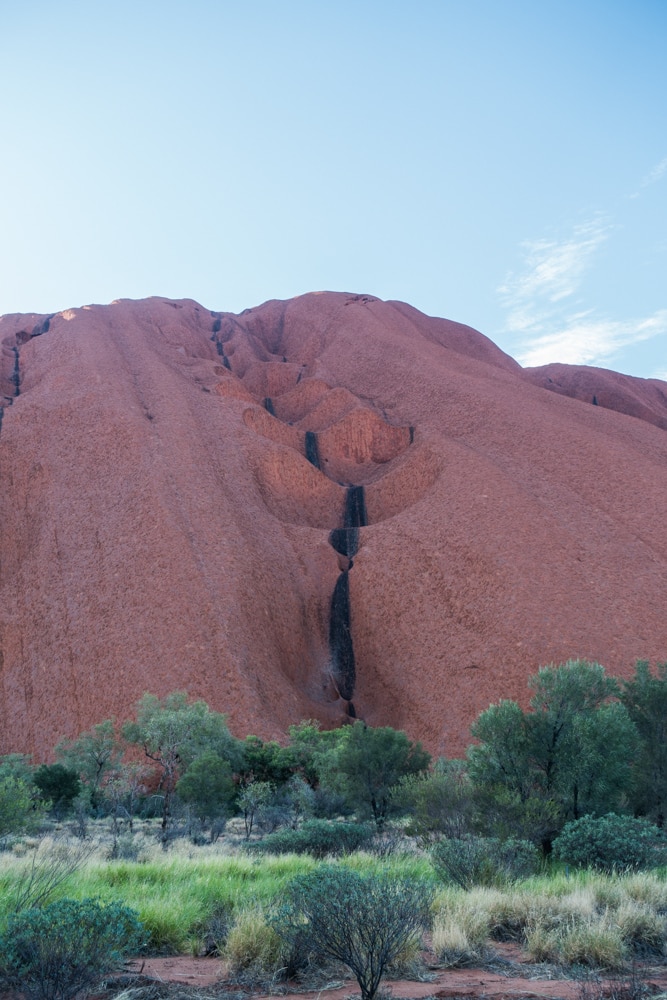

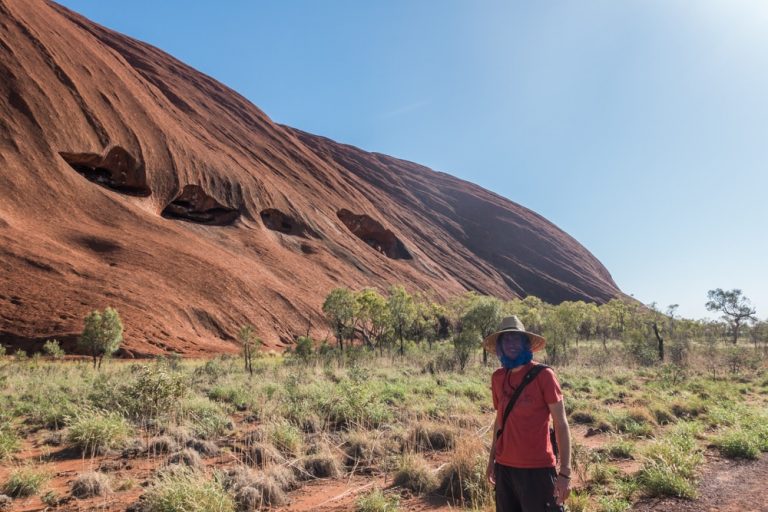
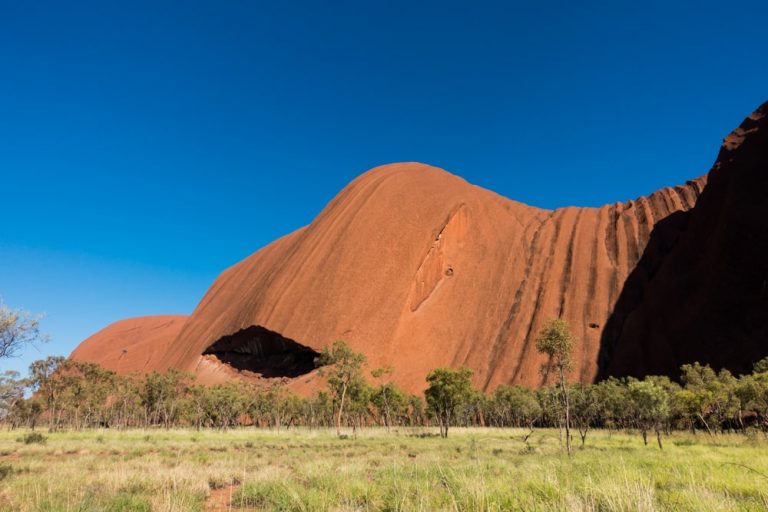
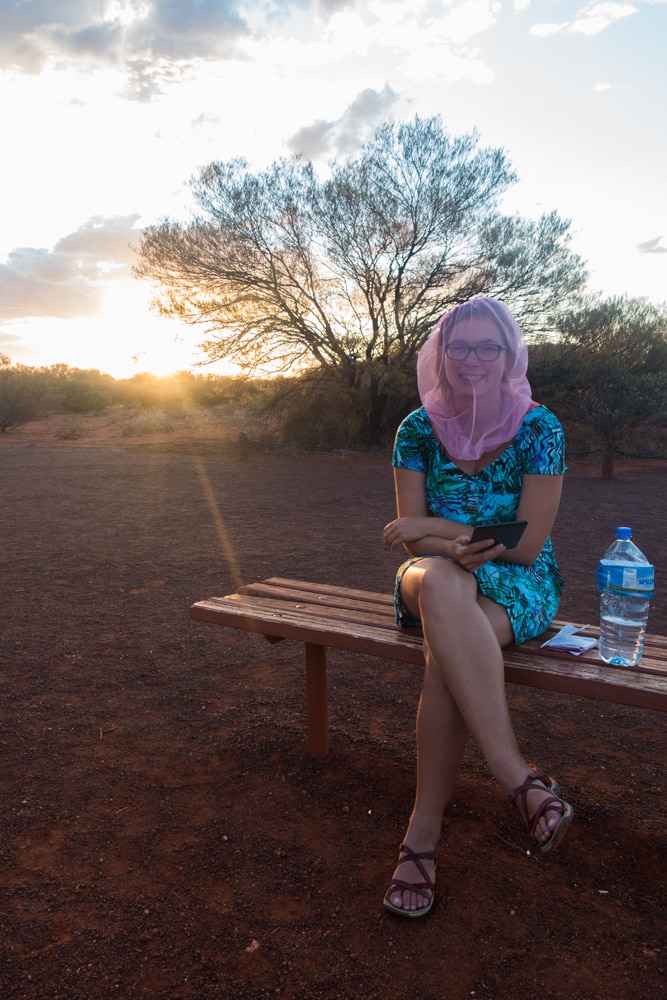
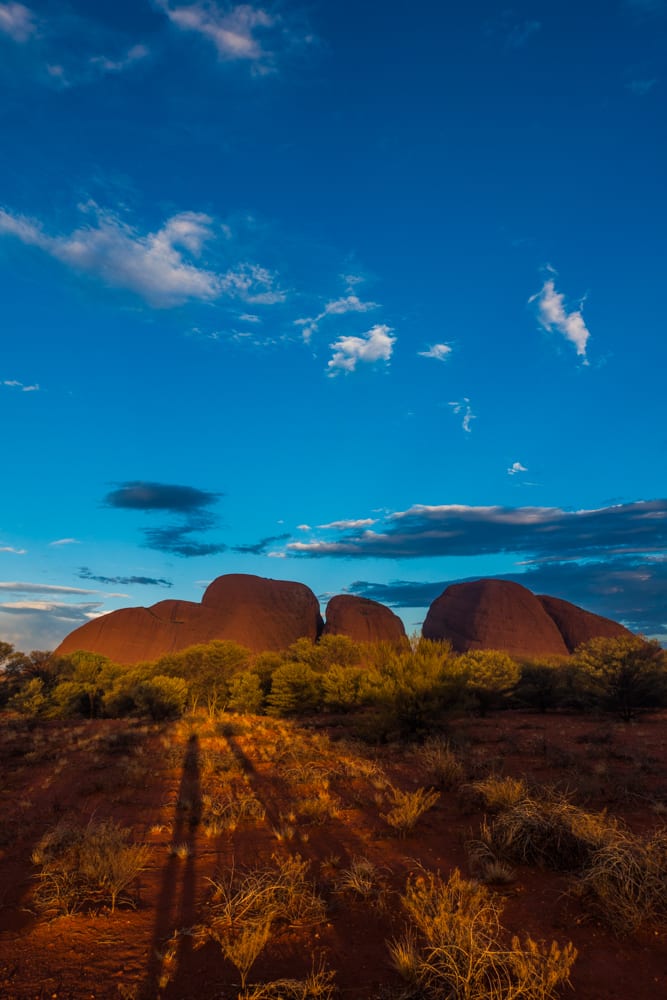


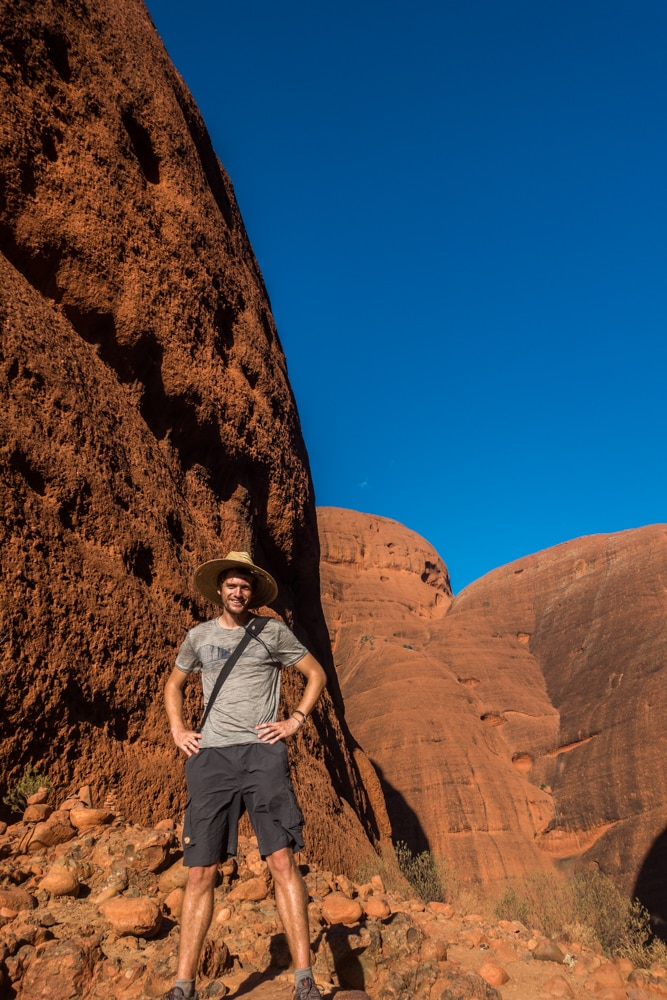
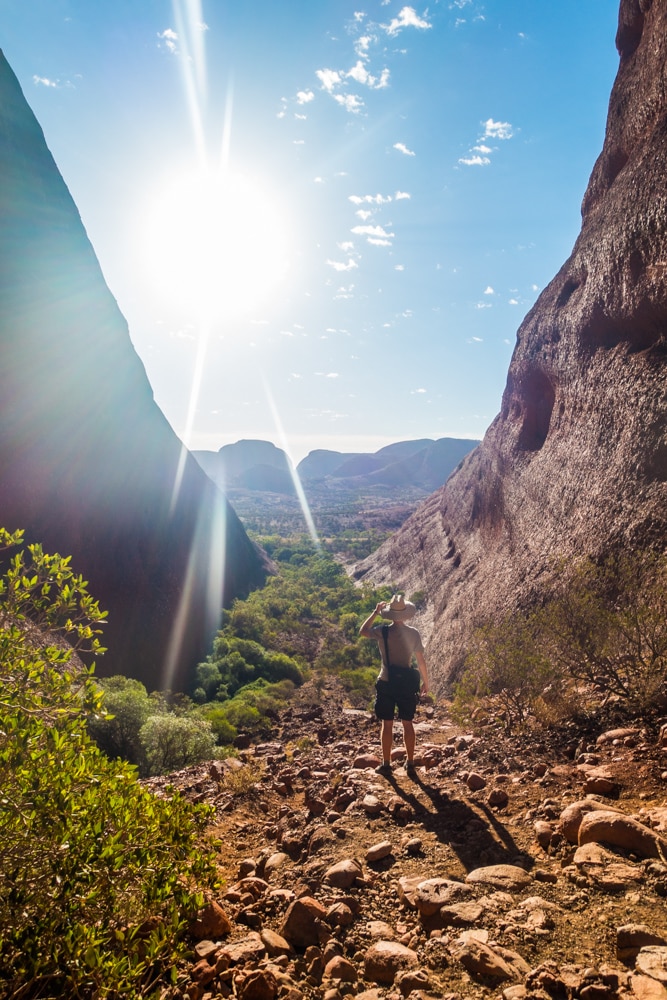

I just found you and am having the best time seeing where you’ve been and the fabulous wealth of information you’ve included here!!!! Absolutely wonderful!! You’re SO close and have probably booked NZ already, but please think about Papua New Guinea…one of the most exotic and fascinating places I’ve been, and I’ve been to many of the places you’ve been on this journey. Yes or no….I’m SO jealous of your adventure and wish you the best on your continuance!!!
Happy to hear you like our adventures!
Unfortunately we already have flights booked to New Zealand and then the US, so we’ll have to come back for Papua New Guinea another time. It does look like an amazing country, although I have to admit it scares me a little bit as well.
Your pictures are stunning, and it sounds like an incredible experience. I’ve yet to visit myself but it’s on my very long list. This is really informational so I’m have to bookmark this guide for when i finally begin to plan my trip to Uluru!
Thanks, Haylee! We recommend everyone planning a trip to Australia to include Uluru in their itinerary. It was absolutely stunning, and the sunsets and sunrises are gorgeous! You should definitely do the Valley of the Winds Walk, that one was awesome. And I know, we have a very long list too, but you’ll make it there someday!